What do manatees eat?
“What do manatees eat?” is a common question when it comes to understanding the dietary habits of these remarkable marine mammals. Manatees are herbivores, and their diet primarily consists of vegetation. They consume a variety of aquatic and freshwater plants, including seagrasses, algae, water hyacinths, water lettuce, and duckweed. Understanding what does manatees eat is of utmost importance for several reasons.

Firstly, it helps us determine their nutritional needs and ensure their overall health and well-being. By studying their dietary habits, researchers and conservationists can develop appropriate feeding strategies in captivity and identify critical feeding areas in the wild.
Secondly, comprehending their diet enables the conservation of their food sources and habitats. Preserving these crucial resources ensures the sustenance of manatee populations and supports their ecological role in maintaining healthy marine environments. Additionally, knowledge of their dietary preferences aids in assessing the impact of environmental changes and potential threats to their food sources, facilitating effective conservation efforts. By unraveling what manatees eat, we can actively contribute to their conservation and ensure the preservation of these gentle marine giants.
Herbivorous Nature of Manatees: What do manatees eat?
A. Explanation of manatees as herbivores
Manatees are fascinating creatures with a herbivorous diet, meaning they primarily consume plant material. Their feeding habits are characterized by the absence of meat or other animal products. Instead, manatees rely on a variety of vegetation as their main source of nourishment. This distinguishes them from carnivores or omnivores, as their digestive systems have evolved to efficiently process and extract nutrients from plant-based food sources.
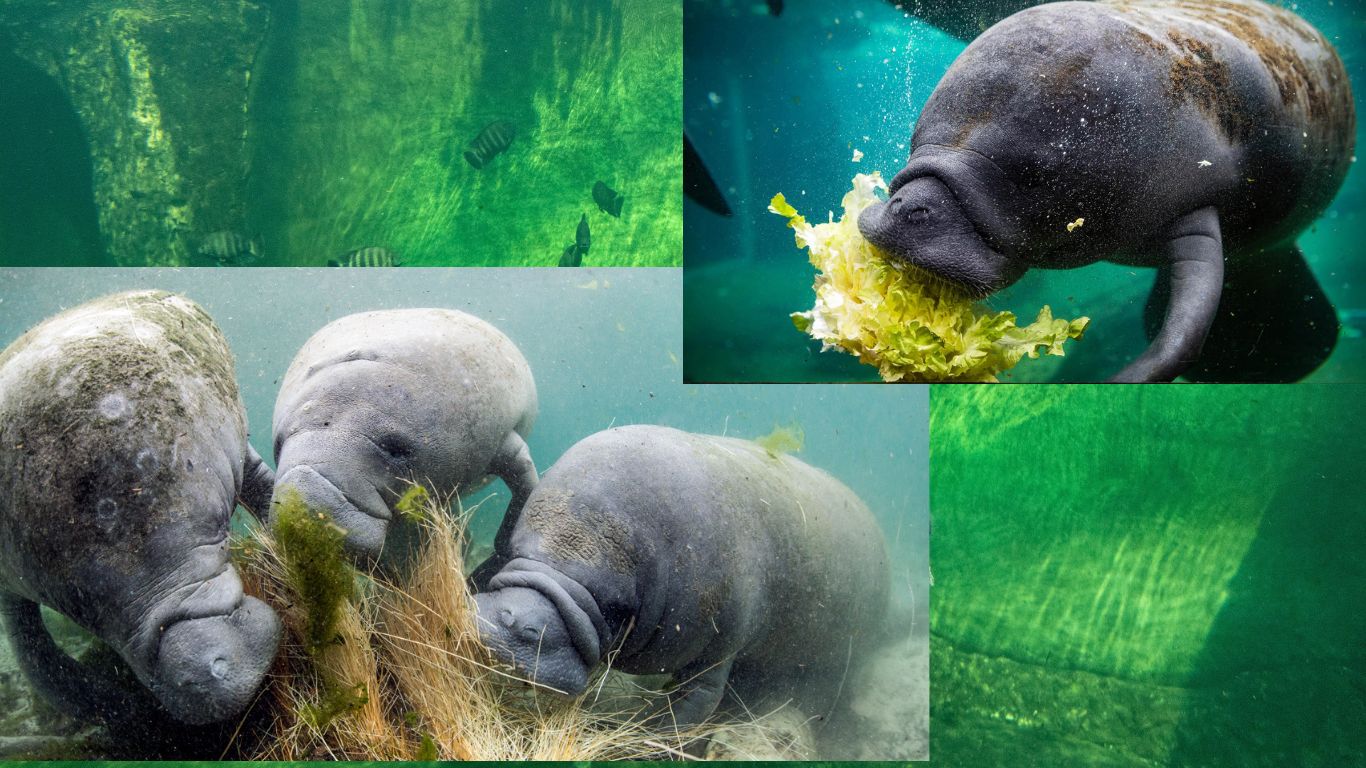
B. Adaptations for feeding on vegetation
Manatees have specific adaptations that facilitate their feeding on vegetation. Firstly, their teeth are designed for grinding and chewing plant matter. They possess broad, flat molars with ridges, which enable them to efficiently break down the tough fibers of plants.
Secondly, manatees have specialized lips and a prehensile upper lip called a “flexible snout.” These features allow them to skillfully browse through vegetation, delicately plucking leaves, shoots, and other parts of plants from the water or shoreline. The flexibility of their lips and snouts enables them to navigate around obstacles and reach into tight spaces to access their food.
Furthermore, manatees have a unique digestive system that aids in processing plant material. They possess a large, fermentation-based hindgut where bacteria help break down the complex carbohydrates present in vegetation. This fermentation process assists in extracting additional nutrients and energy from their plant-based diet.
Manatees consume a variety of vegetation, including seagrasses, algae, freshwater plants like water hyacinths and duckweed, and other aquatic plant species. Their ability to adapt to different types of vegetation allows them to sustain themselves in a range of habitats.
Types of Vegetation Consumed by Manatees
A. Aquatic plants
1. Seagrasses
Manatees have a strong affinity for seagrasses, which are underwater flowering plants. Seagrasses form vast meadows in coastal areas and provide a crucial food source for manatees. They graze on different species of seagrasses, such as turtle grass, manatee grass, and shoal grass, depending on their availability in their respective habitats.

2. Algae
Algae, including both filamentous and macroalgae, make up another significant part of the manatee’s diet. They feed on various types of algae found in their aquatic environments. Algae provide an additional source of nutrients for manatees and can be consumed when other vegetation is scarce.
B. Freshwater plants
1. Water hyacinths
Manatees are known to consume water hyacinths, which are floating aquatic plants with large, round leaves and showy purple flowers. These plants often grow in freshwater habitats, such as rivers and lakes. Water hyacinths are rich in nutrients and are a favored food source for manatees when available.
2. Water lettuce
Another type of freshwater plant consumed by manatees is water lettuce. Water lettuce is a floating plant characterized by its light green leaves, which resemble lettuce leaves. Manatees feed on the tender leaves of water lettuce, particularly in freshwater environments where this plant thrives.
3. Duckweed
Duckweed is a tiny floating plant with small, rounded leaves that form dense mats on the water’s surface. Manatees are known to graze on duckweed, which is highly nutritious and abundant in some freshwater habitats. These mats of duckweed can serve as a significant food source for manatees, especially during certain times of the year.
Understanding the specific types of vegetation consumed by manatees is crucial for their conservation and habitat management. By protecting and preserving the seagrass meadows and freshwater plant habitats, we can ensure the availability of these essential food sources for manatees, promoting their well-being and the overall health of their ecosystems.
Nutritional Value of Manatee’s Diet
A. High fiber content
The diet of manatees is notably high in fiber. The plant material they consume, such as seagrasses, aquatic plants, and freshwater plants, is rich in dietary fiber. This high fiber content plays a vital role in the digestive process of manatees. It aids in maintaining healthy gut function, promoting regular digestion, and facilitating the breakdown of plant fibers to extract nutrients.
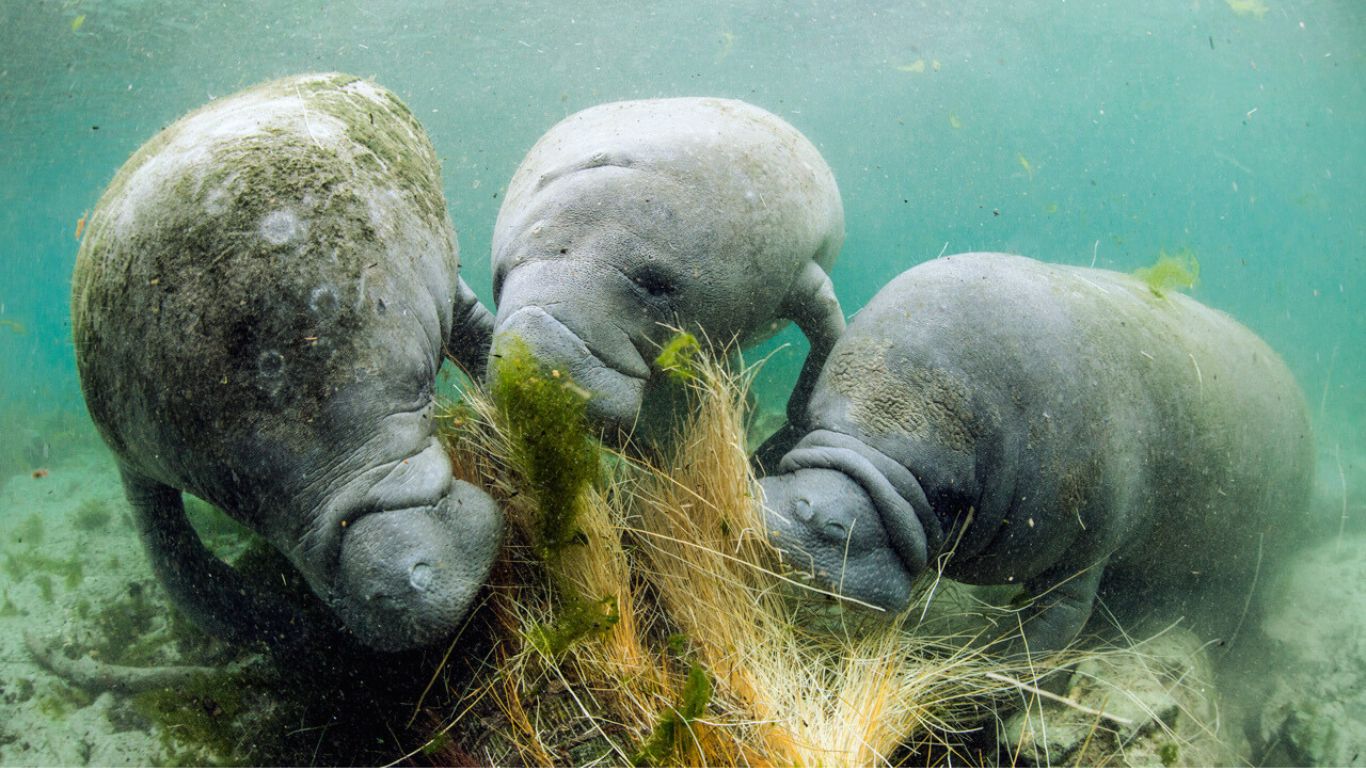
B. Rich in essential nutrients
Manatees’ herbivorous diet provides them with a wide array of essential nutrients. Vegetation consumed by manatees is packed with vitamins, minerals, and other vital compounds. These nutrients include calcium, phosphorus, potassium, vitamins A and C, and various antioxidants. The diverse range of plant species they consume ensures a balanced intake of essential nutrients necessary for their growth, reproduction, and overall well-being.
C. Role of vegetation in maintaining overall health
The vegetation consumed by manatees plays a crucial role in maintaining their overall health. The high fiber content aids in efficient digestion and helps prevent gastrointestinal issues. Additionally, the nutrient-rich plant material supports the development and maintenance of strong bones, muscles, and immune function. The diverse nutritional profile of their diet contributes to their ability to adapt to their environment, resist disease, and sustain optimal health.
By understanding the nutritional value of manatees’ diet, conservationists and researchers can ensure that captive manatees receive a well-balanced and appropriate diet. It also emphasizes the importance of protecting the habitats and food sources of wild manatees, as the availability of diverse vegetation directly impacts their nutritional intake and overall health.
Seasonal Variations in Manatee’s Diet
A. Influence of seasonal changes on vegetation availability
Seasonal variations significantly influence the availability of vegetation for manatees. Changes in water temperature, rainfall patterns, and light availability can impact the growth and abundance of seagrasses, aquatic plants, and freshwater plants. During certain seasons, some food sources may become scarce or less nutritious, requiring manatees to adapt their feeding behaviors and seek alternative food options.
B. Shifting preferences and adaptations
Manatees exhibit remarkable adaptations to cope with seasonal variations in food availability. They demonstrate behavioral flexibility and can adjust their preferences and feeding strategies based on the availability of different plant species. For example, during seasons when seagrass abundance declines, manatees may rely more on other types of vegetation, such as freshwater plants or algae, which are more readily available. They may also travel longer distances to find suitable food sources or congregate in areas where food is more abundant.
Additionally, manatees can adjust their feeding rates and patterns to optimize their energy intake during different seasons. When food is scarce or less nutritious, they may spend more time actively foraging or extend their feeding periods to compensate for the reduced food availability.
These seasonal variations in diet and feeding behavior are critical for manatees’ survival and adaptability. By being flexible in their food choices and adjusting their feeding strategies, manatees can navigate the fluctuations in vegetation availability throughout the year.
Threats to Manatee’s Food Sources
A. Habitat degradation and loss
One of the primary threats to manatee food sources is habitat degradation and loss. Human activities, such as coastal development, dredging, and shoreline modification, can lead to the destruction and fragmentation of seagrass beds and freshwater plant habitats. These activities reduce the availability of suitable feeding areas for manatees and disrupt their access to essential food sources.
B. Pollution and water quality issues
Pollution, including nutrient runoff, sedimentation, and chemical contaminants, poses a significant threat to manatee food sources. Excessive nutrients in the water, often from agricultural runoff or wastewater discharge, can lead to algal blooms that block sunlight and inhibit seagrass growth. Sedimentation can smother and suffocate seagrass beds, reducing their overall health and availability. Chemical contaminants can accumulate in vegetation, impacting its quality and nutritional value. These pollution-related issues directly impact the availability and nutritional content of the food sources for manatees.
C. Impact of climate change
Climate change presents additional challenges to manatee food sources. Rising sea levels and increased water temperatures can lead to the loss and degradation of coastal habitats, including seagrass beds. Changes in precipitation patterns and freshwater availability may impact the abundance and distribution of freshwater plants consumed by manatees. These shifts in environmental conditions can result in altered food availability and quality, affecting the foraging behavior and nutritional intake of manatees.
Conservation Efforts to Protect Manatee’s Food Sources
A. Protected areas and sanctuaries
Conservation efforts for manatees include the establishment of protected areas and sanctuaries that encompass their habitats and critical feeding areas. These designated areas provide a safe haven for manatees and help safeguard their food sources. By implementing regulations and enforcing restrictions on activities such as boating and fishing, these protected areas aim to reduce disturbances and maintain the integrity of the ecosystems that support manatee populations.
B. Restoration and conservation initiatives
Restoration and conservation initiatives focus on restoring and enhancing the health and abundance of vegetation in manatee habitats. These efforts may include reseeding seagrass beds, removing invasive plant species that compete with native vegetation, and implementing water quality improvement programs to reduce nutrient pollution. By promoting the growth and preservation of the manatee’s food sources, these initiatives directly contribute to their long-term survival and well-being.
C. Community education and awareness programs
Community education and awareness programs play a vital role in protecting manatee food sources. These programs aim to educate local communities, stakeholders, and the public about the importance of conserving manatee habitats and the vegetation they rely on. They raise awareness about the potential impacts of human activities, such as pollution and habitat destruction, on the availability of food sources for manatees. By fostering a sense of stewardship and responsibility, these programs encourage individuals to make informed choices that support manatee conservation and the preservation of their food sources.
Conclusion
Manatees are gentle marine mammals with a herbivorous diet, relying predominantly on plant material for their sustenance. Their diet includes seagrasses, aquatic plants, and freshwater plants such as water hyacinths and duckweed. They have specialized adaptations, including teeth for grinding vegetation and flexible lips for browsing, that enable them to efficiently consume and digest their plant-based food sources.
Understanding as what do manatees eat and the importance of preserving their food sources is crucial for their conservation. Manatees play a vital role in aquatic ecosystems as grazers, helping to maintain the health and balance of underwater habitats. By protecting and preserving their food sources, such as seagrass beds and freshwater plant habitats, we ensure the availability of nutritious and diverse vegetation that sustains manatee populations.
Through a combination of protected areas, restoration initiatives, and community education, conservation efforts strive to safeguard the food sources of manatees. By preserving the availability and quality of their vegetation, we can ensure the continued existence of these gentle marine mammals and maintain the ecological balance of their habitats.
Addressing these threats to manatee food sources requires collaborative efforts. Implementing and enforcing habitat protection measures, promoting sustainable coastal development practices, and reducing pollution inputs into waterways are crucial steps. Additionally, mitigating the impacts of climate change through global initiatives to reduce greenhouse gas emissions and implementing local adaptation strategies can help preserve the availability and quality of vegetation for manatees. By addressing these threats, we can ensure the long-term conservation of manatee populations and their essential food sources.
Some other articles which you might be interested in.
Are Manatees Dangerous ?: Here’s What You Need to Know
Are Manatees Endangered ? Understanding the Fate of Manatees
From Backbones to No Bones: Exploring Vertebrates and Invertebrates in Sea Animals
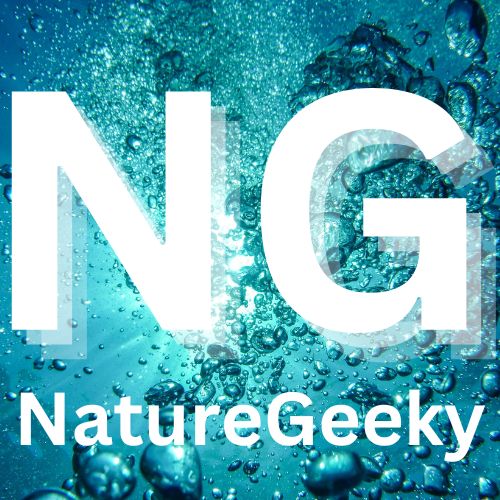
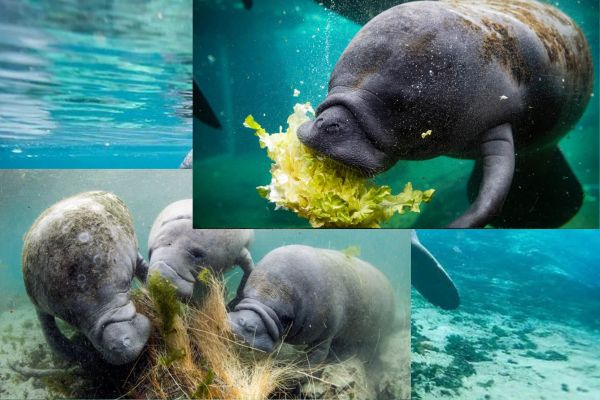
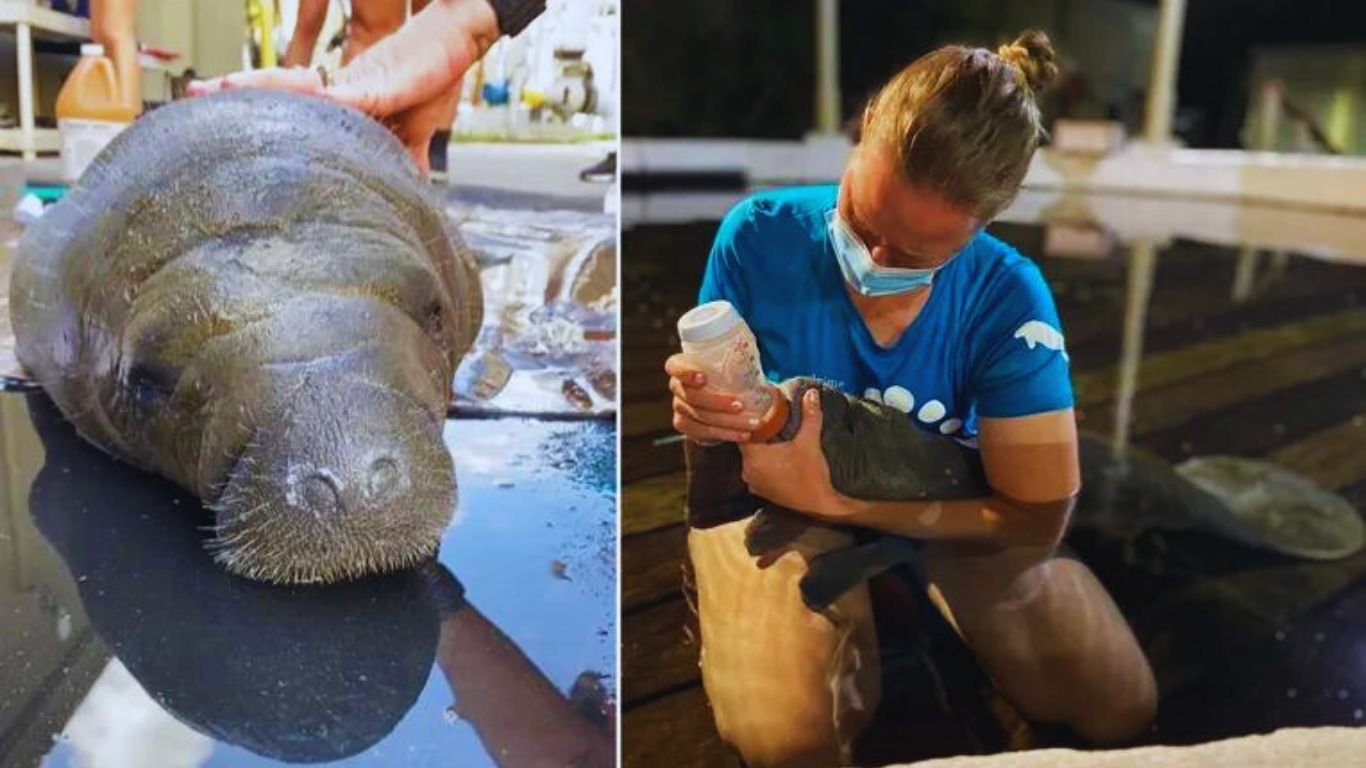
2 thoughts on “What Do Manatees Eat ? Feasting with the Gentle Giants”